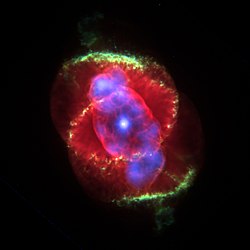NGC 6543
| Nebula | |
|---|---|

Composite image using optical images from the HST and X-ray data from the Chandra X-ray Observatory
|
|
| Observation data: J2000 epoch | |
| Right ascension | 17h 58m 33.423s |
| Declination | +66° 37′ 59.52″ |
| Distance | 3.3±0.9 kly (1.0±0.3 kpc) ly |
| Apparent magnitude (V) | 9.8B |
| Apparent dimensions (V) | Core: 20″ |
| Constellation | Draco |
| Physical characteristics | |
| Radius | Core: 0.2 ly ly |
| Absolute magnitude (V) |
−0.2+0.8 −0.6B |
| Notable features | complex structure |
| Designations | NGC 6543, Snail Nebula, Sunflower Nebula, (includes IC 4677), Caldwell 6 |
Coordinates: ![]() 17h 58m 33.423s, +66° 37′ 59.52″
17h 58m 33.423s, +66° 37′ 59.52″
The Cat's Eye Nebula or NGC 6543, is a relatively bright planetary nebula in the northern constellation of Draco, discovered by William Herschel on February 15, 1786. It was the first planetary nebula whose spectrum was investigated by the English amateur astronomer William Huggins, demonstrating that planetary nebulae were gaseous and not stellar in nature. Structurally, the object has had high-resolution images by the Hubble Space Telescope revealing knots, jets, bubbles and complex arcs, being illuminated by the central hot planetary nebula nucleus (PNN). It is a well-studied object that has been observed from radio to X-ray wavelengths.
NGC 6543 is a high northern declination deep-sky object and is near the apparent position of the North Ecliptic Pole. It has the combined magnitude of 8.1, with high surface brightness. Its small bright inner nebula subtends an average of 16.1 arcsec, with the outer prominent condensations about 25 arcsec. Deep images reveal an extended halo about 300 arcsec or 5 arcmin across, that was once ejected by the central progenitor star during its red giant phase.
...
Wikipedia
